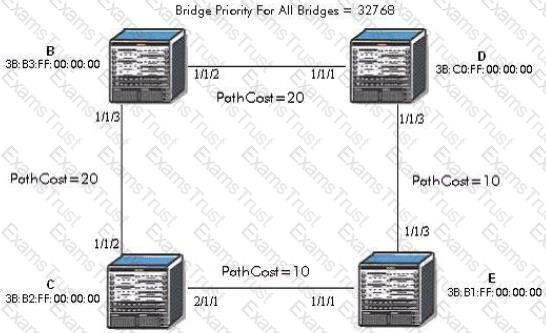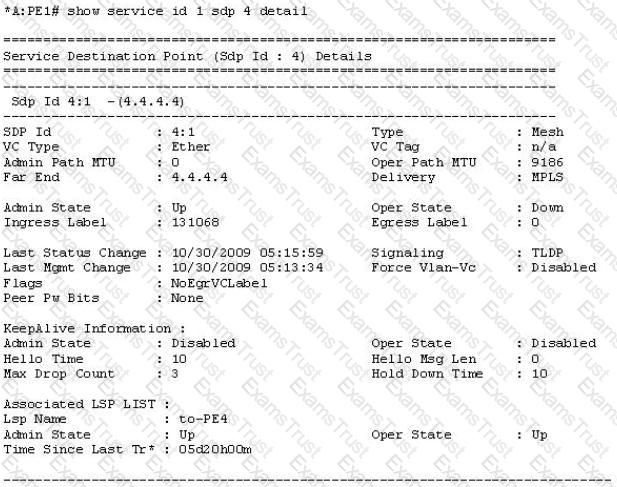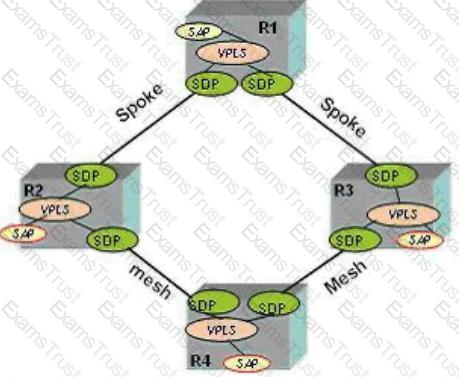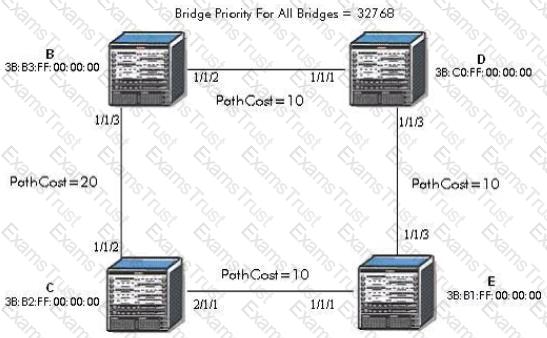Why is it best practice to set the bridge priority in an STP network? (Choose 2)
What is the default Spanning Tree protocol used in a VPLS on the Nokia 7750 SR?
Click on the exhibit below.

Which ports will become root ports? (Choose 3)
Click on the exhibit below.

Management VPLS 100 has been created for redundant spoke-SDP connections. User VPLSs 10 and 20 are using the same spoke-SDPs that are being managed by VPLS 100. Unexpected behavior has been reported. Based on the following output, what is the most likely reason for the unexpected behavior?
Which of the following functions must a PE router support when participating in a VPLS service? (Choose 3)
Which of the following describes the setting of the l-SID on the Nokia 7750 SR?
Click on the exhibit below.

Given the following output what is the most likely reason the SDP binding is operationally down? (Choose 2)
Which of the following is NOT a feature of the IEEE 802.3ah EFM standard?
Which of the following statements relating to VPLS is false?
Fill in the blank for this next sentence. Flooded traffic received on any ____________ in the service is replicated to other spoke SDPs and SAPs and not transmitted on any mesh SDPs.
Which of the following technologies allows for two explicit VLAN tags to be received from a customer device?
Click on the exhibit below.

The MDU attached to this PE has been configured with active/standby SDP's configuration option has been configured for the PE to recognize that this SDP is in standby mode?
Click on the exhibit below.

The VPLS service MTU on R2 is 1514 bytes. What must the service MTU be on all other routers participating in the VPLS?
During the process of troubleshooting a VPLS problem the "oam mac-purge" command with "register" option was used to purge a MAC address from the FDB. Which of the following statements is true?
What is the SA in the Ethernet frame used for by a layer 2 switch?
In Active/Standby pseudowires a failed pseudowire has recovered. Under what circumstances will the active pseudowire revert to the previously failed link?
Which of the following needs to be considered when designing Ethernet networks with redundancy?
The service mtu of a VPLS is set to 9100. What is the recommended MTU value that can be set for the access port assuming dot1q encapsulation?
After the "disable-learning" command has been executed at the VPLS level, a new client device originates a frame. What is the result?
What action will be taken when an Ethernet switch receives a frame with a known DA and an outer Ethertype value of 0x0800 on a dot1q encapsulated port?
Click on the exhibit below.

In the diagram below, SAP 1 is put into the blocking state as a result of the spanning tree protocol. What will occur in the VPLS instance if SAP 2 goes down and SAP 1 transitions to the forwarding state? Select the most accurate statement.
In IEEE 802.1ag, which two key functions are configured on bridge ports (SAPs and SDPs) to support CFM messages? (Choose 2)
Click on the exhibit below.

Which port will become the alternate port?